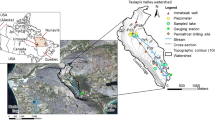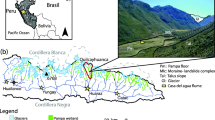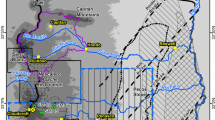Abstract
The McMurdo Dry Valleys (MDVs), Antarctica, exist in a hyperarid polar desert, underlain by deep permafrost. With an annual mean air temperature of −18 °C, the MDVs receive <10 cm snow-water equivalent each year, collecting in leeward patches across the landscape. The landscape is dominated by expansive ice-free areas of exposed soils, mountain glaciers, permanently ice-covered lakes, and stream channels. An active layer of seasonally thawed soil and sediment extends to less than 1 m from the surface. Despite the cold and low precipitation, liquid water is generated on glaciers and in snow patches during the austral summer, infiltrating the active layer. Across the MDVs, groundwater is generally confined to shallow depths and often in unsaturated conditions. The current understanding and the biogeochemical/ecological significance of four types of shallow groundwater features in the MDVs are reviewed: local soil-moisture patches that result from snow-patch melt, water tracks, wetted margins of streams and lakes, and hyporheic zones of streams. In general, each of these features enhances the movement of solutes across the landscape and generates soil conditions suitable for microbial and invertebrate communities.
Résumé
Les vallées sèches de McMurdo (McMurdo Dry Valleys; MDVs), en Antarctique, se trouvent dans un désert polaire hyperaride, reposant sur un permafrost profond. Avec une température moyenne de l’air de −18 °C, les MVDs reçoivent moins de 10 cm d’eau sous forme de neige se rassemblant par plaques sous le vent à travers le paysage. Le paysage est dominé par de vastes zones de sols affleurants libres de glace, des glaciers de montagne, des lacs couverts de glace en permanence et des chenaux de cours d’eau. Une couche active de sol gelé de façon saisonnière et de sédiments se développe sur moins d’1 mètre depuis la surface. Malgré le froid et les faibles précipitations, l’eau sous forme liquide est générée par les glaciers et les plaques de neige durant l’été austral, s’infiltrant à travers la couche active de sol. A travers les MDVs, l’eau est généralement restreinte à des profondeurs faibles et dans des conditions souvent non saturées. La compréhension actuelle et la signification biogéochimique/écologique des particularités de quatre types d’eau souterraine peu profonde dans les MDVS sont examinées : tâches locales d’humidité du sol qui résultent de la fonte de plaques de neige, traces d’eau, berges humides des cours d’eau et lacs et zones hyporhéiques des rivières. En général chacune de ces caractéristiques augmente le mouvement de corps dissous à travers le paysage et génère des conditions de sol favorables aux communautés microbiennes et invertébrées.
Resumen
Los valles McMurdo Dry (MDVs), Antartica, existen en un desierto polar hiperárido suprayacente a un permafrost profundo. Los MDVs, con una temperatura media anual del aire de −18 °C, reciben <10 cm de agua equivalente de nieve cada año, recolectadas a través del paisaje en manchas a sotavento. El paisaje está dominado por extensas áreas libres de hielo en suelos expuestos, glaciares de montaña, lagos permanentemente cubiertos por hielo, y canales de corrientes. Una capa activa de suelo estacionalmente descongelado se extiende en los sedimentos a menos que 1 m de la superficie. A pesar de la baja y fría precipitación, se genera agua líquida en los glaciares y las manchas de nieve durante el verano austral, infiltrándose en la capa activa. A través de los MDVs, el agua subterránea es confinada a profundidades someras y a menudo en condiciones no saturadas. La comprensión actual y el significado biogeoquímica/ecológico de cuatro tipos de características de agua subterránea somera en los MDVs son revisados: las manchas locales de humedad de suelos a partir del derretimiento de manchas de nieve, las vías de agua, los márgenes húmedos de corrientes y lagos, y las zonas hiporreicas de corrientes. En general, cada una de estas características mejora el movimiento de solutos a través del paisaje y genera condiciones de suelos adecuadas para comunidades microbianas y de invertebrados.
摘要
南极洲的McMurdo Dry山谷(MDVs)深层永久冻土下伏有一极端干旱的极地沙漠。该地区多年平均气温 −18 °C,年均降雪小于10cm,并汇集在横穿景区的下风口处。景区是主要由广阔的裸露土壤区、高山冰川、永久冰覆盖湖以及河道主导。季节性消融的土壤和沉积物组成的活动层延伸不到地下1m。尽管南半球的夏季寒冷、降雨少,由冰川及雪堆产生的液态水浸润活动层。横穿MDVs,地下水通常限制在很浅的深度内,且经常处于不饱和状态。总结MDVs四种类型浅层地下水特征的当前理解及其生物地球化学或生态学意义:雪堆融化、水道、河流及湖泊的润湿边缘以及河流的伏流区产生局部土壤水分区。通常每种类型都增加了溶质横穿景区的运移,形成适合微生物及无脊椎动物群体的土壤条件。
Resumo
Os McMurdo Dry Valleys (MDV), Antártida, existem num deserto hiperárido polar sobreposto a permafrost profundo. Com uma temperatura média anual do ar de −18 °C, os MDV recebem por ano <10 cm de água equivalente em neve coletada de sotavento, em manchas dispersas na paisagem. A paisagem é dominada por áreas extensas livres de gelo e com solos expostos, glaciares de montanha, lagos permanentemente cobertos de gelo e canais de escoamento. Uma camada ativa de solo e sedimentos sazonalmente descongelados estende-se até menos de 1 m da superfície. Apesar do frio e da baixa precipitação, a água líquida é gerada em glaciares e em manchas de neve durante o verão austral, infiltrando-se na camada ativa. Através dos MDV a água subterrânea é geralmente limitada a profundidades reduzidas e muitas vezes em condições não saturadas. É revisto o entendimento atual e o significado biogeoquímico/ecológico de quatro tipos de características da água subterrânea pouco profunda nos MDV: manchas localizadas de humidade do solo que resultam da fusão de manchas de neve, percursos de escoamento de água, margens húmidas de linhas de água e lagos, e zonas hiporreicas de linhas de água. Em geral, cada uma dessas características promove o movimento de solutos através da paisagem e gera as condições de solo apropriadas para comunidades microbianas e de invertebrados.












Similar content being viewed by others
References
Ayres E, Wall DH, Adams B, Barrett JE, Virginia RA (2007) Unique similarity of faunal communities across aquatic–terrestrial interfaces in a polar desert ecosystem. Ecosystems 10:523–535. doi:10.1007/s10021-007-9035-x
Ball BA, Virginia RA, Barrett JE, Parsons AN, Wall DH (2009) Interactions between physical and biotic factors influence CO2 flux in Antarctic dry valley soils. Soil Biol Biochem 41:1510–1517
Barrett JE, Virginia RA, Hopkins DW, Aislabie J, Bargagli R, Bockheim JG, Campbell IB, Lyons WB, Moorhead DL, Nkem JN, Sletten RS, Steltzer H, Wall DH, Wallenstein MD (2006a) Terrestrial ecosystem processes of Victoria Land, Antarctica. Soil Biol Biochem 38:3019–3034
Barrett JE, Virginia RA, Wall DH, Cary SC, Adams BJ, Hacker AL, Aislabie JM (2006b) Co-variation in soil biodiversity and biogeochemistry in Northern and Southern Victoria Land, Antarctica. Antarct Sci 18:535–548
Barrett JE, Virginia RA, Wall DH, Adams BJ (2008) Decline in a dominant invertebrate species contributes to altered carbon cycling in a low-diversity soil ecosystem. Glob Change Bio 14:1734–1744. doi:10.1111/j.1365-2486.2008.01611.x
Barrett JE, Gooseff MN, Tacaks-Vesbach C (2009) Spatial variation in soil active-layer geochemistry across hydrologic margins in polar desert ecosystems. Hydrol Earth Syst Sci 13:2349–2358
Bockheim JG (1997) Properties and classification of Cold Desert soils from Antarctica. Soil Sci Soc Am J 61:224–231
Bockheim JG (2002) Landform and soil development in the McMurdo Dry Valleys, Antarctica: a regional synthesis. Arct Antarct Alp Res 34:308–317
Bockheim JG (2008) Functional diversity of soils along environmental gradients in the Ross Sea region, Antarctica. Geoderma 144:32–42
Bockheim JG, Campbell IB, McLeod M (2007) Permafrost distribution and active layer depths in the McMurdo Dry Valleys, Antarctica. Permafr Periglac Process 18:217–227
Bomblies A, McKnight DM, Andrews ED (2001) Retrospective simulation of lake-level rise in Lake Bonney based on recent 21-yr record: indication of recent climate change in the McMurdo Dry Valleys, Antarctica. J Paleolimnol 25:477–492
Burkins MB, Virginia RA, Chamberlain CP, Wall DH (2000) Origin and distribution of soil organic matter in Taylor Valley, Antarctica. Ecology 81:2377–2391
Campbell IB (2003) Soil characteristics at a long-term ecological research site in Taylor Valley, Antarctica. Aust J Soil Res 41:351–364
Campbell IB, Claridge GGC, Balks MR, Campbell DI (1997) Moisture content in soils of the McMurdo Sound and Dry Valley Region of Antarctica. In: Lyons WB, Howard-Williams C, Hawes I (eds) Ecosystem processes in Antarctic ice-free landscapes. Taylor and Francis, London, pp 61–76
Cartwright K, Harris HJH (1981) Hydrogeology of the Dry Valley Region, Antarctica. In: McGinnis L (ed) Dry Valley Drilling project. Antarctic Research Series, AGU, Washington, DC, pp 193–214
Chinn TJ (1993) Physical hydrology of the dry valley lakes. In: Green WJ, Friedman EI (eds) Physical and biogeochemical processes in Antarctic lakes. Antarctic Research Series, AGU, Washington, DC, pp 1–51
Clow GD, McKay CP, Simmons GM Jr, Wharton RA Jr (1988) Climatological observations and predicted sublimation rates at Lake Hoare, Antarctica. J Climatol 1:715–728
Conovitz PA, MacDonald LH, McKnight DM (2006) Spatial and temporal active layer dynamics along three glacial meltwater streams in the McMurdo Dry Valleys, Antarctica. Arct Antarct Alp Res 38:42–53
Cozzetto K, McKnight DM, Nylen T, Fountain AG (2006) Experimental investigations into processes controlling stream and hyporheic temperatures, Fryxell Basin, Antarctica. Adv Water Resour 29:130–153
Doran PT, McKay CP, Clow GD, Dana GL, Fountain AG, Nylen T, Lyons WB (2002) Valley floor climate observations from the McMurdo Dry Valleys, Antarctica, 1986–2000. J Geophys Res 107:4772. doi:4710.1029/2001JD002045
Downes MT, Howard-Williams C, Vincent WF (1986) Sources of organic nitrogen, phosphorus and carbon in Antarctic streams. Hydrobiologia 134:215–225
Eveland J, Gooseff MN, Lampkin DJ, Barrett JE, Takacs-Vesbach C (2012) Spatial and temporal patterns of snow accumulation and aerial ablation across the McMurdo Dry Valleys, Antarctica. Hydrol Proc. doi:10.1002/hyp.9407
Fountain AG, Nylen TH, Monaghan A, Basagic HJ, Bromwich D (2010) Snow in the McMurdo Dry Valleys, Antarctica. Int J Climatol 30:633–642. doi:10.1002/joc.1933
Gooseff MN, McKnight DM, Lyons WB, Blum AE (2002) Weathering reactions and hyporheic exchange controls on stream water chemistry in a glacial meltwater stream in the McMurdo Dry Valleys. Water Resour Res 38:WR000834
Gooseff MN, Barrett JE, Doran PT, Fountain AG, Lyons WB, Parsons AN, Porazinska DL, Virginia RA, Wall DH (2003a) Snow-patch influence on soil biogeochemical processes and invertebrate distribution in the McMurdo Dry Valleys, Antarctica. Arct Antarct Alp Res 35:91–99. doi:10.1657/1523-0430(2003)035%5B0091:SPIOSB%5D2.0.CO;2
Gooseff MN, McKnight DM, Runkel RL, Vaughn BH (2003b) Determining long time-scale hyporheic zone flow paths in Antarctic streams. Hydrol Proc 17:1691–1710
Gooseff MN, McKnight DM, Runkel RL (2004a) Reach-scale cation exchange controls on major ion chemistry of an Antarctic glacial meltwater stream. Aquat Geochem 10:221–238
Gooseff MN, McKnight DM, Runkel RL, Duff JH (2004b) Denitrification and hydrologic transient storage in a glacial meltwater stream, McMurdo Dry Valleys, Antarctica. Limnol Oceanogr 49:1884–1895
Gooseff MN, Lyons WB, McKnight DM, Vaughn BH, Fountain AF, Dowling C (2006) A stable isotopic investigation of a polar desert hydrologic system, McMurdo Dry Valleys, Antarctica. Arct Antarct Alp Res 38:60–71
Gooseff MN, Barrett JE, Northcott ML, Bate B, Hill KR, Zeglin LH, Bobb M, Takacs-Vesbach CD (2007) Controls on the spatial dimensions of wetted hydrologic margins of two Antarctic lakes. Vadose Zone J 6:841–848
Green WJ, Canfield DE (1984) Geochemistry of the Onyx River (Wright Valley, Antarctica) and its role in the chemical evolution of Lake Vanda. Geochim Cosmochim Acta 48:2457–2467
Green WJ, Angle MP, Chave KE (1988) The geochemistry of Antarctic streams and their role in the evolution of four lakes of the McMurdo Dry Valleys. Geochim Cosmochim Acta 52:1265–1274
Harris HJH, Cartwright K (1981) Hydrology of the Don Juan Basin, Wright Valley, Antarctica. In: McGinnis L (ed) Dry valley drilling project, Antarctic Research Series, AGU, Washington, DC, pp 161–184
Harris KJ, Carey AE, Lyons WB, Welch KA, Fountain AG (2007) Solute and isotope geochemistry of subsurface ice melt seeps in Taylor Valley, Antarctica. Geol Soc Am Bull 119:548–555
Hastings SJ, Luchessa SA, Oechel WC, Tenhunen JD (1989) Standing biomass and production in water drainages of the foothills of the Philip Smith Mountains, Alaska. Holarct Ecol 12:304–311
Ikard SJ, Gooseff MN, Barrett JE, Takacs-Vesbach C (2009) Thermal characterisation of active layer across a soil moisture gradient in the McMurdo Dry Valleys, Antarctica. Permafr Periglac Process 20:27–39
Kleinberg RL, Griffin DD (2005) NMR measurements of permafrost: unfrozen water assay, pore-scale distribution of ice, and hydraulic permeability of sediments. Cold Regions Sci Tech 42:63–77
Koch JC, McKnight DM, Neupauer RM (2011) Simulating unsteady flow, anabranching, and hyporheic dynamics in a glacial meltwater stream using a coupled surface water routing and groundwater flow model. Water Resour Res 47:W05530. doi:05510.01029/02010WR009508
Levy JS (2012) Hydrological characteristics of recurrent slope lineae on Mars: evidence for liquid flow through regolith and comparisons with Antarctic terrestrial analogs. Icarus 219:1–4
Levy JS, Fountain AG, Gooseff MN, Welch KA, Lyons WB (2011) Water tracks and permafrost in Taylor Valley, Antarctica: extensive and shallow groundwater connectivity in a cold desert ecosystem. Geol Soc Am Bull 123:2295–2311
Lyons WB, Mayewski PA (1993) The geochemical evolution of terrestrial waters in the Antarctic: the role of rock-water interactions. In: Green WJ, Friedman EI (eds) Physical and biogeochemical processes in Antarctic lakes. AGU, Washington, DC, pp 135–143
Lyons WB, Welch KA, Nezat CA, Crick K, Toxey JK, Mastrine JA, McKnight DM (1997) Chemical weathering rates and reactions in the Lake Fryxell Basin, Taylor Valley: comparison to temperate river Basins. In: Lyons WB, Howard-Williams C, Hawes I (eds) Ecosystem processes in Antarctic ice-free landscapes. Taylor and Francis, London
Lyons WB, Welch KA, Neumann K, Toxey JK, McArthur R, Williams C, McKnight DM, Moorhead D (1998) Geochemical linkages among glaciers, streams, and lakes within the Taylor Valley, Antarctica. In: Priscu JC (ed) Ecosystem dynamics in a polar desert: the McMurdo Dry Valleys, Antarctica. Antarctic Research Series, AGU, Washington, DC
Lyons WB, Fountain AG, Doran PT, Priscu JC, Neumann K, Welch KA (2000) Importance of landscape position and legacy: the evolution of the lakes in Taylor Valley, Antarctica. Freshwater Biol 43:355–367
Lyons WB, Welch KA, Carey AE, Doran PT, Wall DH, Virginia RA, Fountain AG, Csatho BM, Tremper CM (2005) Groundwater seeps in Taylor Valley Antarctica: an example of a subsurface melt event. Ann Glaciol 40:200–206
McGinnis LD, Jensen TE (1971) Permafrost-hydrogeologic regimen in two ice-free valleys, Antarctica, from electrical depth sounding. Quat Res 1:31–38. doi:10.1016/0033-5894(71)90073-1
McKnight DM, Niyogi DK, Alger AS, Bomblies A, Conovitz PA, Tate CM (1999) Dry valley streams in Antarctica: ecosystems waiting for water. BioSci 49:985–995
McKnight DM, Runkel RL, Tate CM, Duff JH, Moorhead D (2004) Inorganic N and P dynamics of Antarctic glacial meltwater streams as controlled by hyporheic exchange and benthic autotrophic communities. J N Am Bethol Soc 23:171–188
McNamara JP, Kane DL, Hinzman LD (1999) An analysis of an arctic channel network using a digital elevation model. Geomorphology 29:339–353
Michalski G, Bockheim JG, Kendall C, Thiemens M (2005) Isotopic composition of Antarctic dry Valley nitrate: implication for NOy sources and cycling in Antarctica. Geophys Res Lett 32:L13817. doi:13810.11029/12004GL022121
Nezat CA, Lyons WB, Welch KA (2001) Chemical weathering in streams of a polar desert (Taylor Valley, Antarctica). Geol Soc Am Bull 113:1401–1408
Nielsen UN, Wall DH, Adams BJ, Virginia RA, Ball BA, Gooseff MN, McKnight DM (2012) The ecology of pulse events: insights from an extreme climatic event in a polar desert ecosystem. Ecosphere 3(2):17. doi: http://dx.doi.org/10.1890/ES11-00325.1. Accessed November 2012
Nkem JN, Virginia RA, Barrett JE, Wall DH, Li G (2006) Salt tolerance and survival thresholds for two species of Antarctic soil nematodes. Polar Biol 29:643–651
Northcott ML, Gooseff MN, Barrett JE, Zeglin LH, Takacs-Vesbach CD, Humphrey J (2009) Hydrologic characteristics of lake- and stream-side riparian wetted margins in the McMurdo dry valleys, Antarctica. Hydrol Proc 23:1255–1267
Nylen T, Fountain AG, Doran PT (2004) Climatology of katabatic winds in the McMurdo dry valleys, southern Victoria Land, Antarctica. J Geophys Res 109:D03114. doi:03110.01029/02003JD003937
Parsons AN, Barrett JE, Wall DH, Virginia RA (2004) Soil carbon dioxide flux in Antarctic Dry Valley ecosystems. Ecosystems 7:286–295
Poage MA, Barrett JE, Virginia RA, Wall DH (2008) The influence of soil geochemistry on nematode distribution, McMurdo Dry Valleys, Antarctica. Arct Antarct Alp Res 40:119–128
Runkel RL, McKnight DM, Andrews ED (1998) Analysis of transient storage subject to unsteady flow: diel flow variation in an Antarctic stream. J N Am Bethol Soc 17:143–154
Starinsky A, Katz A (2003) The formation of natural cryogenic brines. Geochim Cosmochim Acta 67:1475–1484
Takacs-Vesbach C, Zeglin LH, Priscu JC, Barrett JE, Gooseff MN (2010) Factors promoting microbial diversity in the McMurdo Dry Valleys, Antarctica. In: Doran P, Lyons WB, McKnight DM (eds) Life in Antarctic deserts and other cold dry environments: astrobiological analogues. Cambridge University Press, Cambridge, UK, pp 221–257
Treonis AM, Wall DH, Virginia RA (1999) Invertebrate biodiversity in Antarctic Dry Valley soils and sediments. Ecosystems 2:482–492
Treonis AM, Wall DH, Virginia RA (2002) Field and microcosm studies of decomposition and soil biota in a cold desert soil. Ecosystems 5:159–170
Virginia RA, Wall DA (1999) How soils structure communities in the McMurdo Dry Valleys, Antarctica. Bioscience 49: 973–983
Walsh JE (2009) A comparison of Arctic and Antarctic climate change, present and future. Antarct Sci 21:179–188
Welch KA, Lyons WB, Whisner C, Gardner CB, Gooseff MN, McKnight DM, Priscu JC (2010) Spatial variations in the geochemistry of glacial meltwater streams in Taylor Valley, Antarctica. Antarct Sci 22:662–672
Wilson AT (1979) Geochemical problems of the Antarctic dry areas. Nature 280:205–208
Wilson AT (1981) Geochemistry and lake physics of the Antarctic dry areas. In: McGinnis LD (ed) Dry Valley Drilling project, Antarctic Research Series vol 33, AGU, Washington, DC, pp 185–192
Zeglin LH, Sinsabaugh RL, Barrett JE, Gooseff MN, Takacs-Vesbach CD (2009) Landscape distribution of microbial activity in the McMurdo Dry Valleys: Linked biotic processes, hydrology and geochemistry in a cold desert ecosystem. Ecosystems 12:562–573
Zeglin LH, Dahm CN, Barrett JE, Gooseff MN, Fitpatrick SK, Takacs-Vesbach CD (2011) Bacterial community structure along moisture gradients in the parafluvial sediments of two ephemeral desert streams. Microb Ecol 61:543–556
Acknowledgements
The authors gratefully acknowledge their Antarctic collaborators and colleagues, Raytheon Polar Services for logistical support, Petroleum Helicopters, Inc. for logistical support, and funding support from NSF grant numbers, ANT-0851965, ANT-1043785, ANT-0830050, ANT-0838879, and ANT-0838922. Any opinions, findings, and conclusions or recommendations expressed in this material are those of the authors and do not necessarily reflect the views of the National Science Foundation.
Author information
Authors and Affiliations
Corresponding author
Additional information
Published in the theme issue “Hydrogeology of Cold Regions”
Rights and permissions
About this article
Cite this article
Gooseff, M.N., Barrett, J.E. & Levy, J.S. Shallow groundwater systems in a polar desert, McMurdo Dry Valleys, Antarctica. Hydrogeol J 21, 171–183 (2013). https://doi.org/10.1007/s10040-012-0926-3
Received:
Accepted:
Published:
Issue Date:
DOI: https://doi.org/10.1007/s10040-012-0926-3




